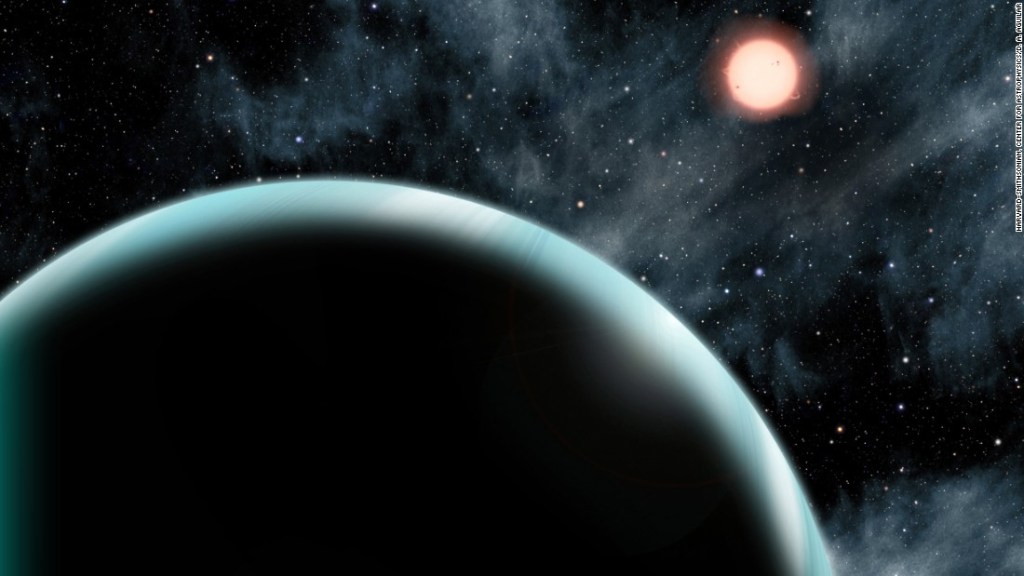Webb telescope to study Earth-like planets 0:48
(CNN) -
Since the first exoplanets were discovered in the 1990s, many have wondered if we could find another Earth there, a place called Planet B.
Natalie Batalha, a professor of astronomy and astrophysics at the University of California, Santa Cruz, has seen the field of exoplanet science grow and change since those initial discoveries.
Batalha served as a co-investigator and mission scientist on the Kepler mission.
This is the first mission capable of searching for Earth-sized planets around other stars and transformed the science of exoplanets.
NASA will deliberately crash a spacecraft into an asteroid in the name of planetary defense
"The first decade of exoplanets was the collecting of postage stamps, where a planet is discovered one at a time," he said.
"But then Kepler launched and broke a bottleneck in terms of sensitivity. We were discovering hundreds of planets at once. (The James Webb telescope) will give us this new lens to study exoplanet diversity. We are entering this third epoch of characterization. of the atmosphere of exoplanets ".
So far, the exoplanet study has not revealed another Earth, and that is unlikely even with the upcoming launch of the James Webb Space Telescope in December.
The observatory will examine the interior of the atmospheres of exoplanets that orbit stars much smaller than our sun.
"One of the key things about Webb is understanding if they really do have at least some of the habitability properties, but it won't be a true analog to Earth," said Klaus Pontoppidan, Webb project scientist at the Space Telescope Science Institute at Baltimore.
James Webb, controversial name for NASA's telescope 0:55
But the planets you will study could be connected to an intriguing idea: what if life occurs differently outside of Earth?
And it's something that the successors to this telescope could investigate for decades to come.
advertising
"There really is no Planet B for us," said Jill Tarter, an astronomer and former director of the SETI Research Center who currently holds the Emeritus Chair for the research center.
"Unless we find a way to solve all the global problems that we face here and mitigate those challenges, wherever we go we will create the same problems that we have created here on this planet. There is no escape hatch."
What is Planet B?
Kepler-421b is a Uranus-sized transiting exoplanet with the longest known year, circling its star once every 704 days.
The planet orbits an orange K-type star that is cooler and dimmer than our Sun and is located about 1,000 light-years from Earth in the constellation Lyra.
Harvard-Smithsonian, Center for Astrophysics / DA Aguilar
If there is a Planet B somewhere, does it look more like Earth or will it surprise us and be something completely unexpected?
"When we find a Planet B, I want it to be a true twin of Earth, a planet that orbits a star similar to the sun and with an orbit similar to Earth that has a thin atmosphere and oceans and continents," said Sara Seager, astrophysicist. , planetary scientist and professor at the Massachusetts Institute of Technology.
NASA discovers the first possible planet outside our galaxy
As astronomers have wanted to point out, each telescope has brought a host of unexpected discoveries in addition to the things they planned to observe.
Planet B could be similar.
"I really want us to be able to find life in something that doesn't look much like Earth," said Nikole Lewis, an astrophysicist and assistant professor of astronomy at Cornell University.
"It's safe for us to say that if it looks like Earth and smells like Earth, then it's probably Earth and therefore has life. That's not adventurous enough for me, so I'd love to kick it up and really get started. to look at the atmospheric chemistry and temperature of planets that are perhaps a little bit larger than Earth, "he said.
The search for Planet B is not in black and white: it is incredibly complicated, balancing what we understand about the process of life on Earth with what we do not know.
On Earth, even in its most extreme environments, life is based on carbon, liquid water has its role to play as a solvent for biochemistry and DNA encodes genetic information, Batalha said.
It stands to reason that life elsewhere is probably carbon-based and dependent on water.
And hydrogen, oxygen, and carbon are very abundant elements in the universe.
"Planet B, according to our appearance, is a planet with liquid water on the surface," Batalha said.
"In addition to looking for biosignatures, I think what Webb could do better is look for signs of a habitable environment."
NASA's Viper rover will search for water on the Moon 1:01
It's also possible that if conditions aren't right elsewhere, life might find a way to "exist in niches and maybe even find other biochemical pathways when it's difficult," he said.
Perhaps life on another planet can use methanol instead of water for biochemistry, or we will develop different metrics and signatures to detect habitable planets and life on them in the future, he said.
The key factor the astronomers we spoke to agreed on was keeping an open mind in the search for life, and a reminder to respect what we found.
"If there is a Planet B, by definition, it is not our planet," Batalha said.
"We talk about this idea of looking for habitable worlds as if they were ours to take. And if a planet is exactly like Earth with the conditions for life, then by definition it is a living world and it is not ours."
Identify a sign of life
Webb telescope to study Earth-like planets 0:48
Webb is likely not the key tool for identifying signs of life on another planet.
That task is for future telescopes, such as the one described in the recently published 10-year Astro2020 study that will analyze 25 potentially habitable exoplanets.
"We know how to find that planet, but it was postponed until 2045 or later," Seager said.
Life, as we understand it, needs energy, liquid and the right temperature, he explained.
What happens when a possible sign of life is detected?
Finding the signal is fantastic - determining the next step is crucial, Seager said.
Identifying "habitable worlds" is a top priority for astronomers in the next decade
If it is determined that there was no other way to create a potential life sign, collaboration will be a key aspect, Lewis said.
Collaboration with chemists, biologists, and people from different disciplines outside of astronomy and planetary science can determine the way forward.
"My hope is that we are careful, and that we engage with all the relevant experts to try to understand if this is, in fact, a signature that could only mean that there is life on this planet, and then hopefully announced such a thing. for the public, "Lewis said.
And it probably won't be a singular moment that happens overnight, according to Batalha.
"It will unfold for a long time as we continue to study the biochemistry of the world because whatever biosignature we can think of, it has to show that there is no other abiotic (physical, rather than biological) way to produce that signal. That will take a long time." .
The search for life is a journey that will involve traveling new paths, asking new questions and developing new hypotheses.
Then, experiments will be designed to help answer those questions.
Batalha hopes that future telescopes can help scientists complete the planetary census, including how often Earth-like planets occur in the galaxy.
"I think the most important thing is that we keep moving forward and keep moving forward," Batalha said.
A newly discovered exoplanet could have rain clouds
Understanding the importance of what scientific observations and results mean in the search for life is a priority for NASA, as identified in a recent report.
Led by Jim Green, NASA's chief scientist, the paper encourages the establishment of a new scale for evaluating the evidence that answers the question of whether we are really alone.
"Having a scale like this will help us understand where we are in terms of searching for life in particular places and in terms of the capabilities of the missions and technologies that help us in that search," Green said in a statement.
The seven levels of the scale reflect a series of steps along the way to proclaim a positive outcome in the search for life beyond Earth.
"So far, we have prepared the public to think that there are only two options: it is life or it is not life," Mary Voytek, director of NASA's Astrobiology Program, said in a statement.
"We need a better way to share the excitement of our discoveries and demonstrate how each discovery builds on the next, so that we can take the public and other scientists on the journey."
The enduring search for life
Tarter believes that the answer to finding life may depend on technosignatures, rather than biosignatures, because the evidence for past or present technology is "potentially much less ambiguous."
Biosignatures can be gases or molecules that show signs of life.
Technosignatures are signals that could be created by intelligent life.
They are "something that we can observe to indicate that not only is there life on a distant planet, but that it is logically competent and has built or created something that we can observe with our ever-improving abilities to look at the universe," he said.
A new space telescope could detect potentially dangerous asteroids heading for Earth
Since the 1960s, scientists have been listening to radio signals or looking for wavelengths of optical light that indicate someone is transmitting something.
If an intelligent civilization "modified its environment by building solar collectors to collect a lot of energy and reuse it for use on a planetary surface, we may be able to see the consequences of using that technology," said Tarter, who is encouraged by the investment in missions that investigate the search for past and current life in our own solar system, such as the many missions that explore Mars, Dragonfly that will explore Saturn's moon Titan, and Europa Clipper that will fly through columns of oceanic material on the moon of Jupiter.
Perseverance will search for ancient life on Mars.
These are the next places
In the future, he expects missions that go even deeper into the planets than the Perseverance rover, which collects rock samples on Mars.
Exploring more than 10 meters could show evidence of ancient technology.
"I think a century from now will have done a good job exploring for life, but I really like to keep an open mind," said Tarter.
If the samples collected by Perseverance, which will be returned to Earth by future missions in the 2030s, show evidence of ancient biological life on Mars, another question arises.
"Are we Martians? At the beginning of the solar system, there was a lot of material exchange, the collisions were abundant and the pieces of rock that fell off from Mars ended up landing on Earth," said Tarter.
"Life may have started somewhere other than Earth."
An even more exciting possibility is the example of a second genesis if biology on Mars is not related to us, but an independent origin of life, Tarter noted.
"That would mean it happened twice, and it's ubiquitous anywhere. It's amazing. I hope I live to see it."
Science and SpaceExoplanet






/cloudfront-eu-central-1.images.arcpublishing.com/prisa/PA5TT2ZCYBDNLEAREMUPESRVOM.jpg)


/cloudfront-eu-central-1.images.arcpublishing.com/prisa/6BTHUDPEMVESRITAHZQQF4WVF4.jpg)





